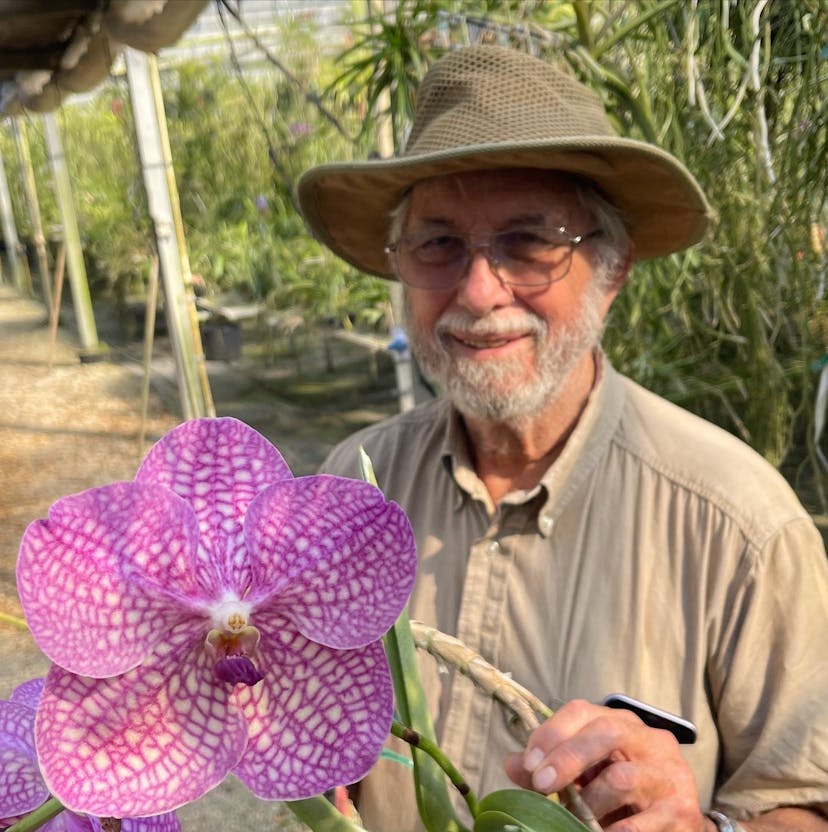
Martin Motes

Biography
The author, Martin R. Motes Ph.D., a Research Associate at Fairchild Tropical Botanic Garden, has maintained a lifelong interest in the genus Vanda. He began as a boy in the late 50’s collecting the new hybrids which were coming out of Hawaii and Singapore and growing them in a shade house in Miami. While still in high school, he started to import Vanda species from India, Indonesia, the Philippines and Thailand in substantial quantities in order to select the best flowered forms for hybridization and for propagation. His career in horticulture, like the careers of most American males of his generation, was disrupted by the war in Vietnam. Following a Ph.D., several years teaching college in Ohio, and a Fulbright lectureship in Kosovo, he was able to return to his beloved Florida and begin breeding with the remnants of his Vanda collection.
By the mid-70’s thanks to the pioneering work of Rapee Sagarik, the center of Vanda breeding had shifted to Thailand and the Thai breeders were producing large flowered Vanda hybrids in a wide range of colors. The author at the time realized that only a limited number of species had contributed to these hybrids and that other species had much to contribute aesthetically. He thus began a breeding program to introduce more Vanda species to modern bloodlines. To do so he continued to import large numbers of species plants from which superior parents could be selected. A decade on the initial results of this breeding program were published in the American Orchid Society Bulletin. His insights into both the hybrids and the species evolved into a book from Timber Press, Vandas, their History, Botany and Culture. By the time of the 18th World Orchid Conference in Dijon, the unique hybrids he had produced were striking enough to garner all of the medals given in the initial international judging and one V. Mary Motes was voted Best in Show and given a Gold Medal.
Shortly thereafter Dr. David Roberts of Kew, invited Motes to collaborate on a monograph of Vanda. David assembled loans of herbarium specimens from all the major herbariums except Vienna. David also assembled most of the relevant literature for us to discuss. He recruited Lauren Gardiner to do a molecular analysis of the genus from herbarium specimens as well as the living collection of Motes Orchids for her doctoral thesis. The results of her work were published in Renziana, to which Martin also made major contributions.
As one result of this research, Motes identified from a drawing by J.J. Smith, a Vanda species that had not been described and he journeyed to Bacan Island where he was able to locate a flower from a cultivated source which is the type specimen of V. alicae. This experience inspired him to travel to Ambon to unravel the mystery of Rumphius’ V. furva, which he discovered on the adjacent island of Ceram along with Rumphius’ other Vanda species, V. saxatilis. Motes’s explorations have continued, leading to the discovery in the South Moluccas of V. bartholomewii described in this volume.
Motes wrote the cultural notes on Aeridinae of Genera Orchidacearum VI, the definitive taxonomic work on the suborder.
Motes continues to breed hybrids and improve Vanda species. He continues his research of the genus as well.
Talks and Abstracts
Temperature Tolerant Low Light Vandas
Darwin On Orchids
New Directions in Vanda Breeding
The Genus Paraphalaenopsis and it’s Hybrids
The genus Renanthera and its Hybrids
Intergeneric Vandaceous Hybrids

FREE ACCESS: Orchid DealWire
Get notified when orchid vendors have special promotions and exclusive savings.







